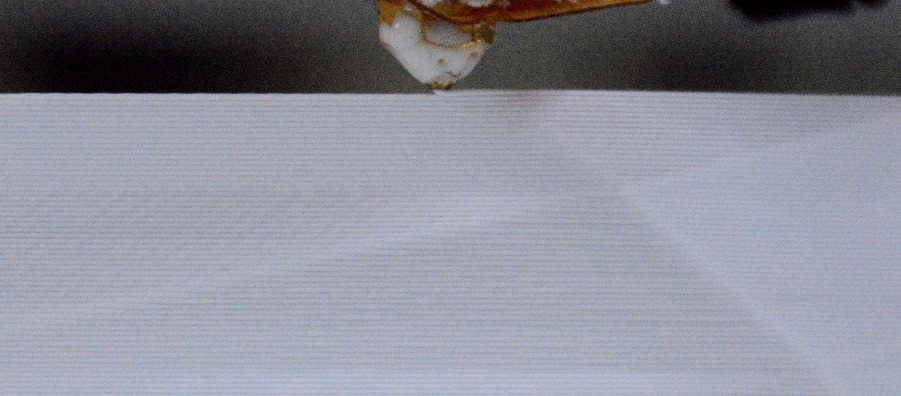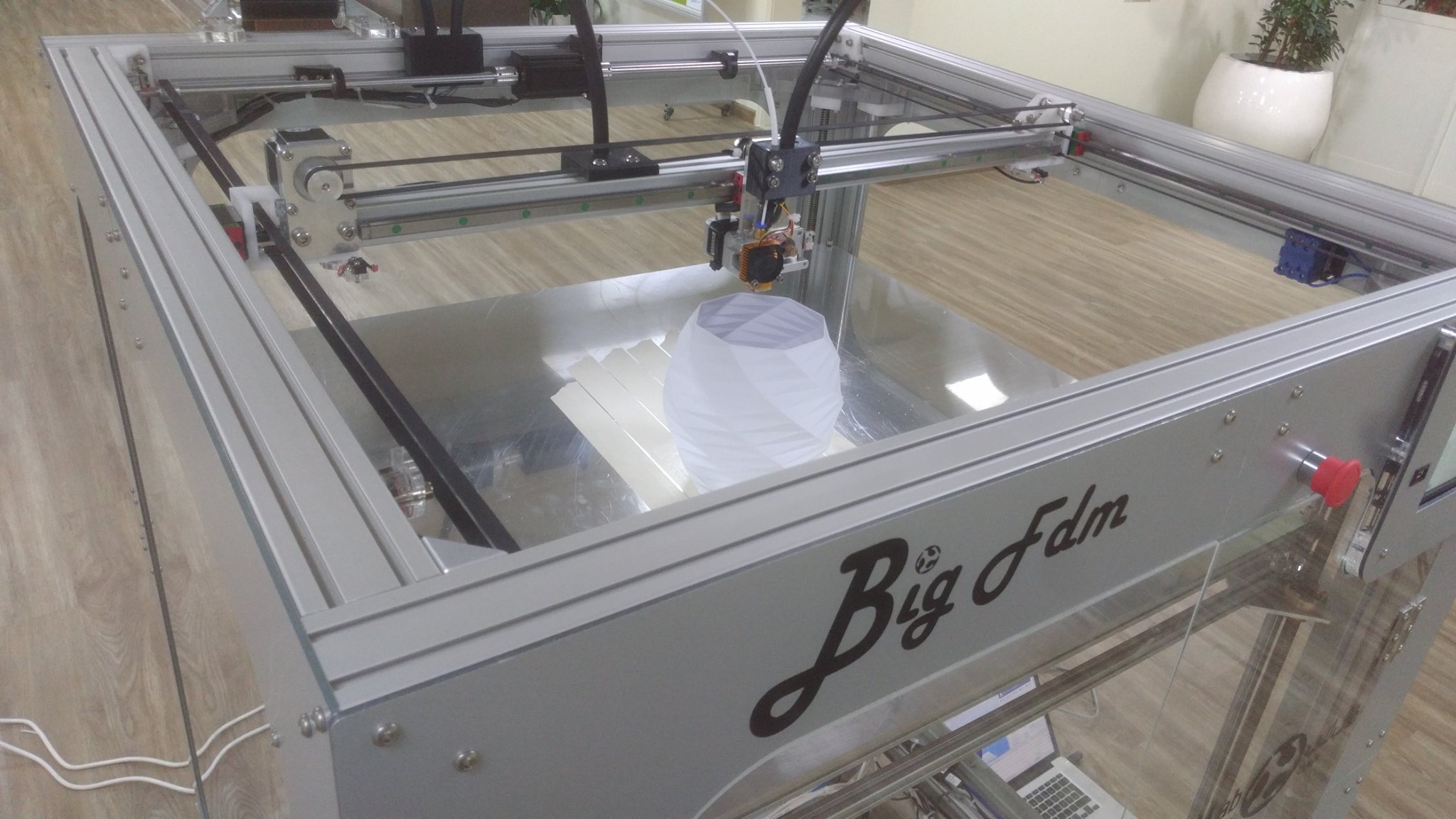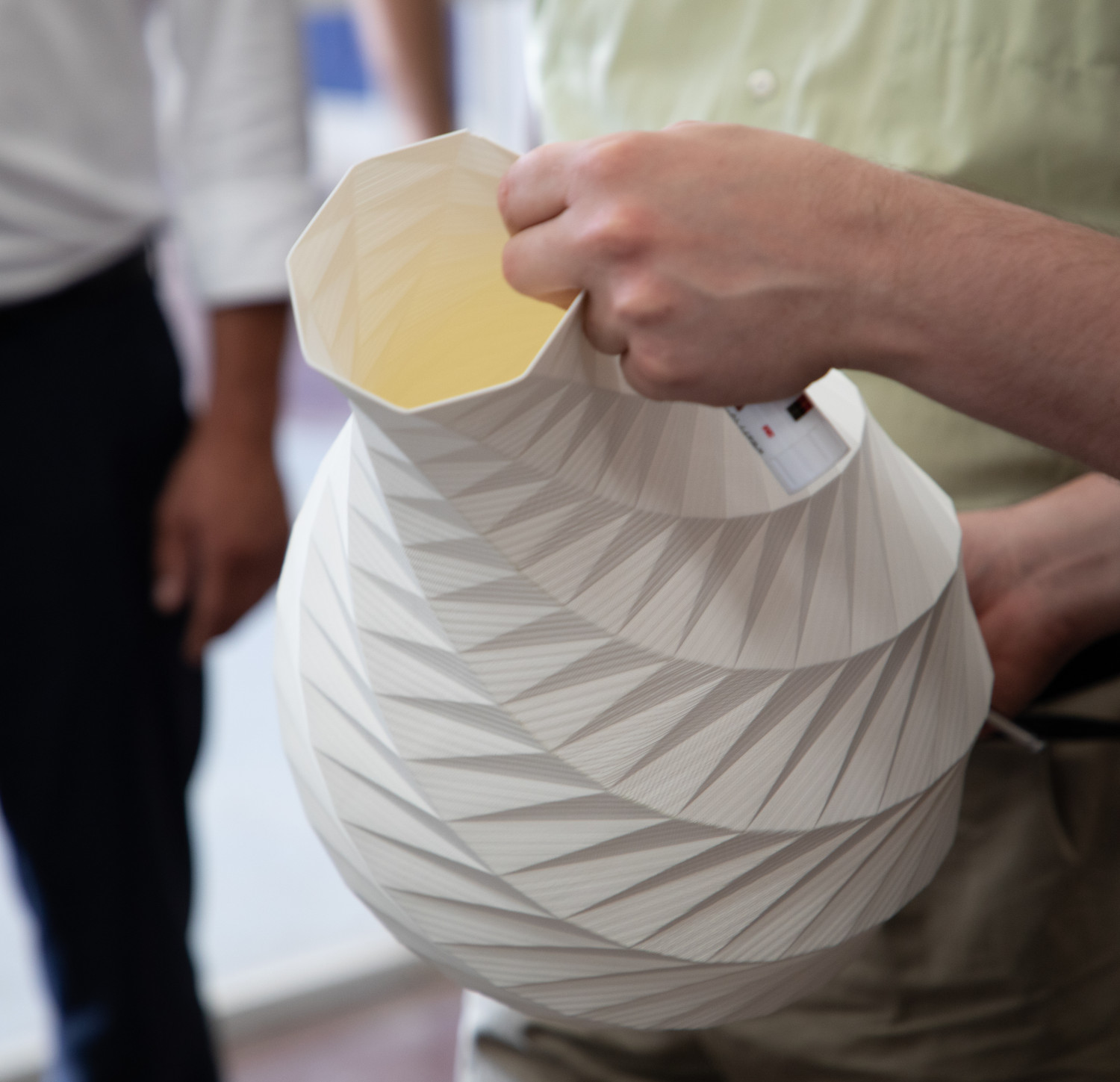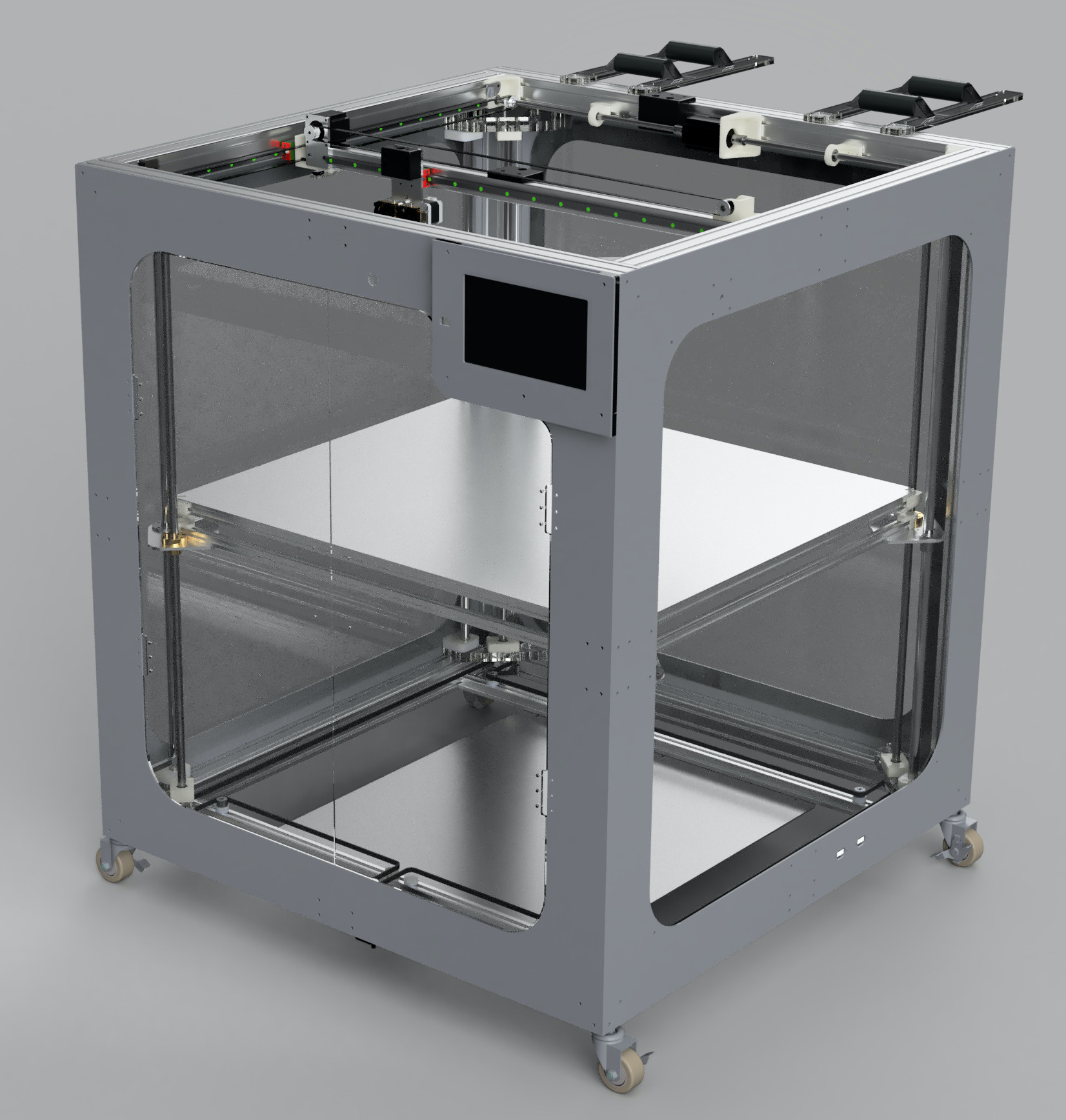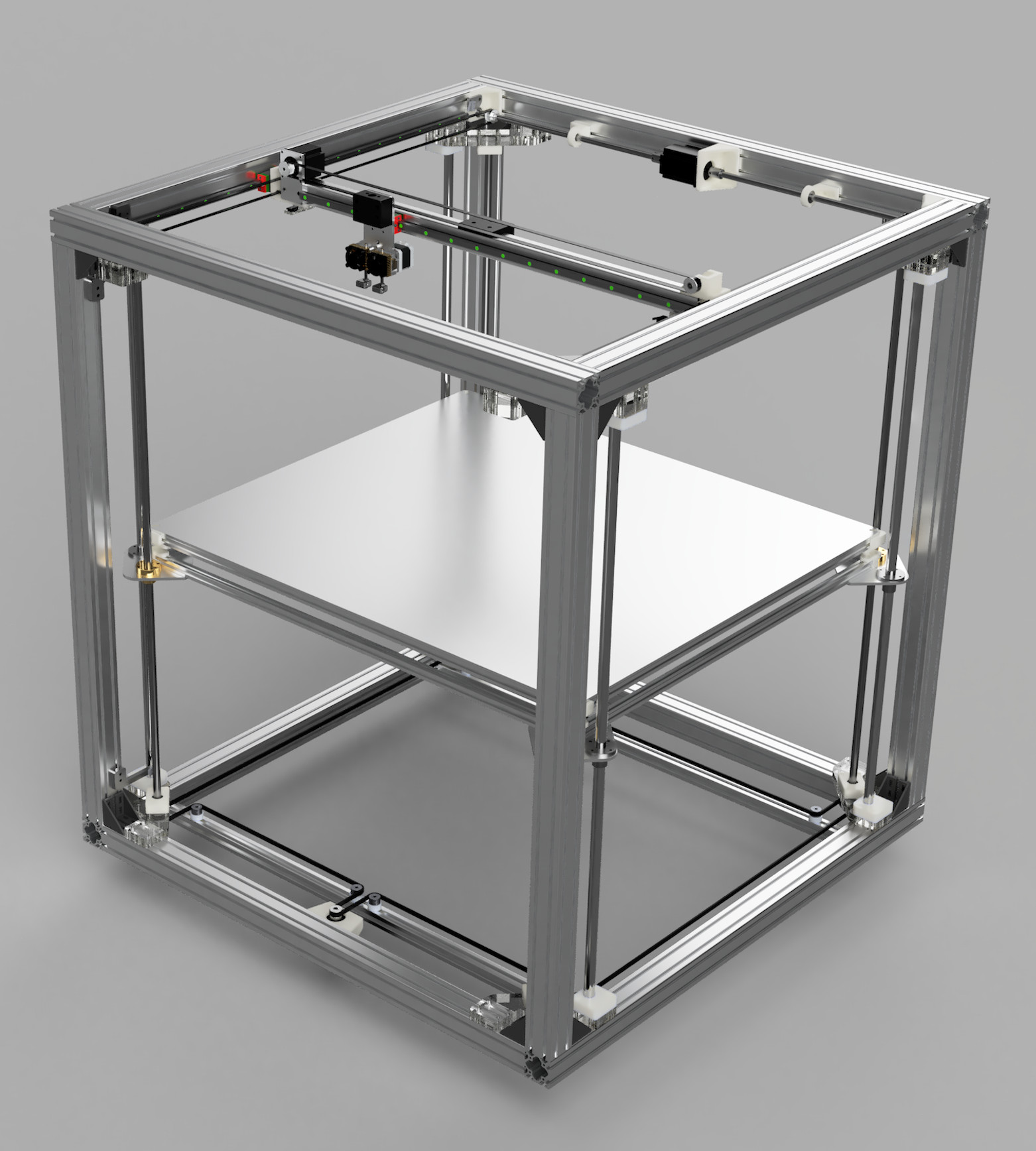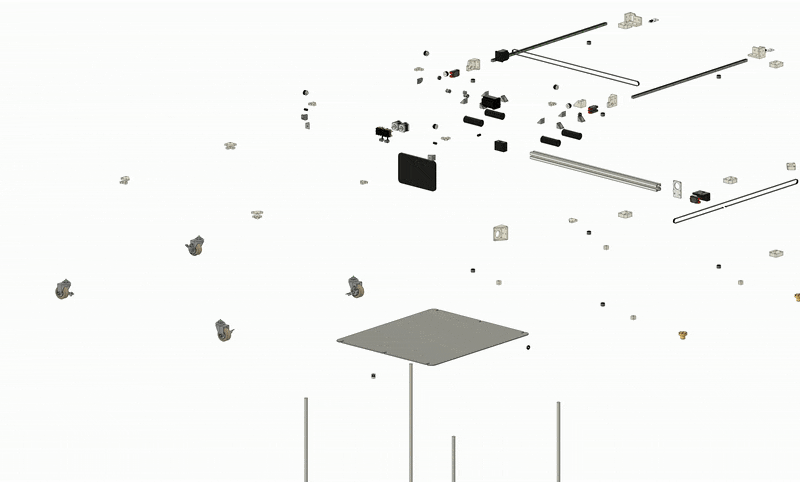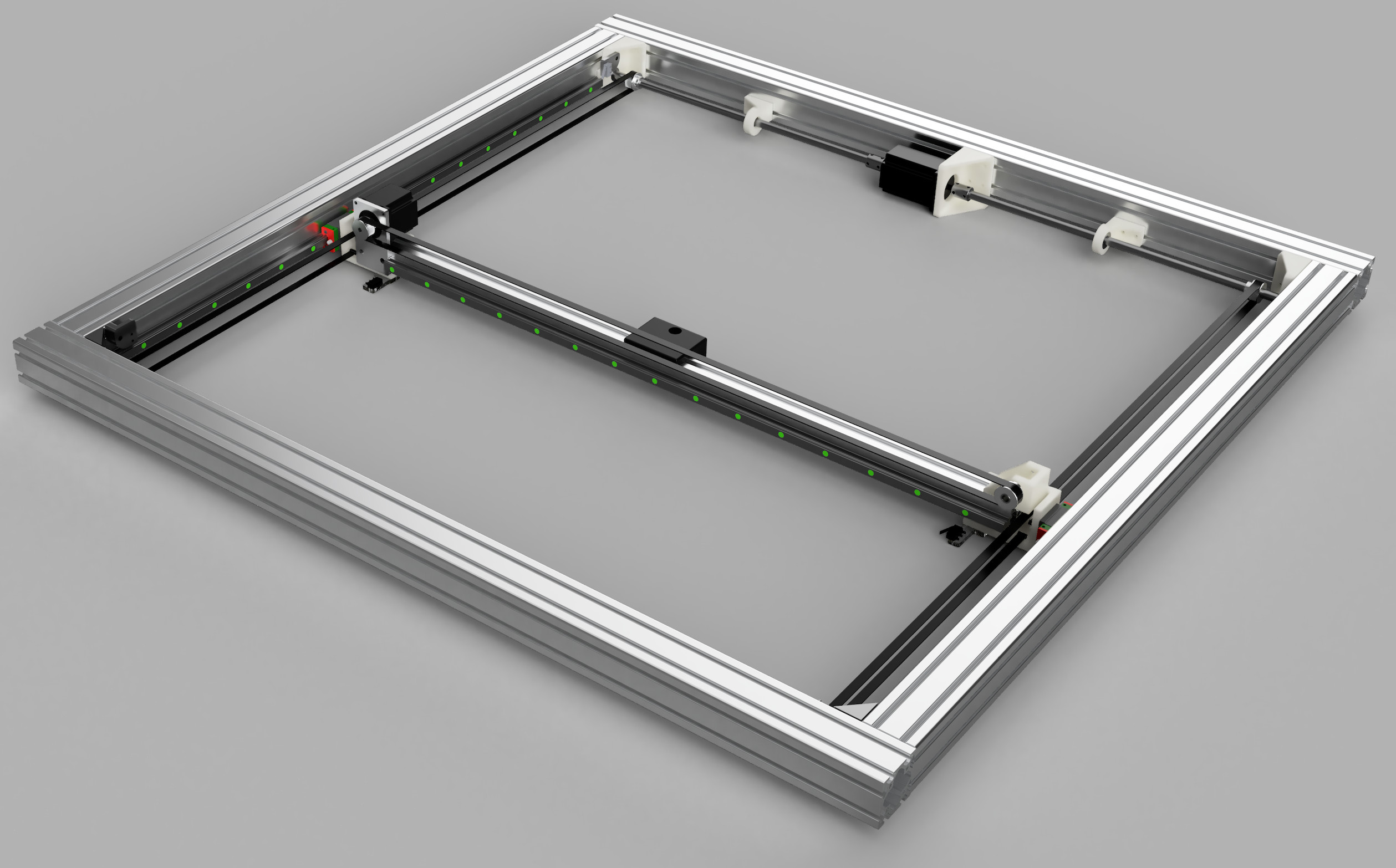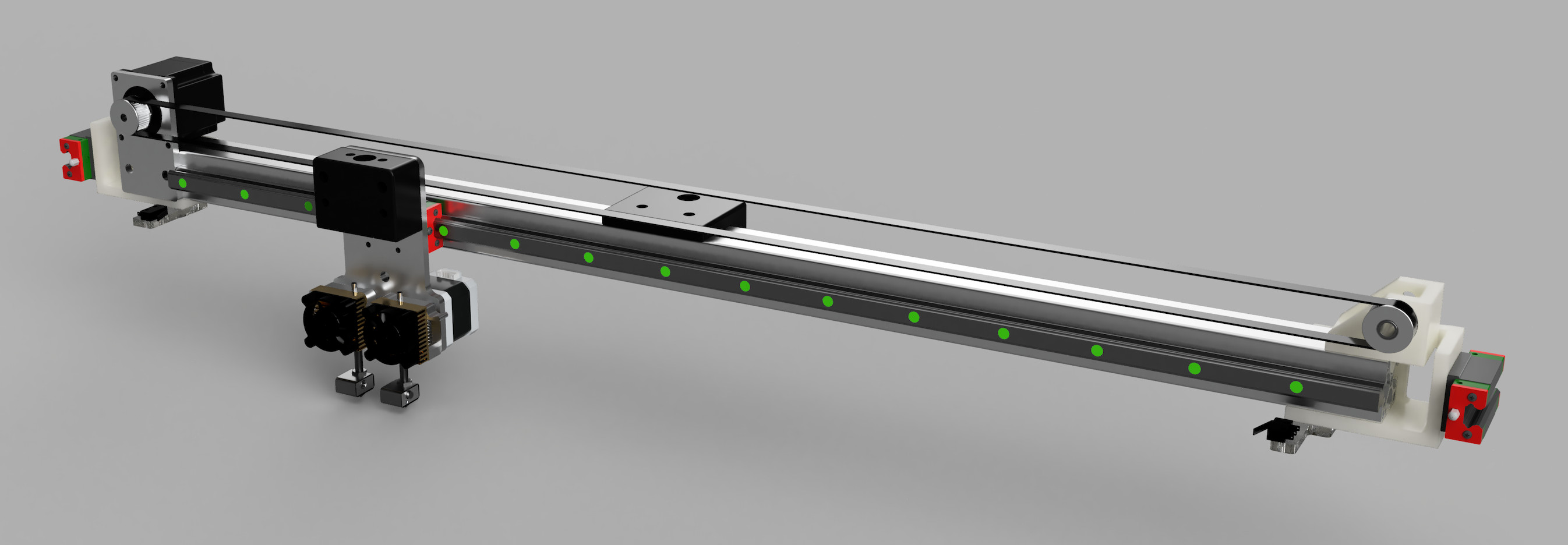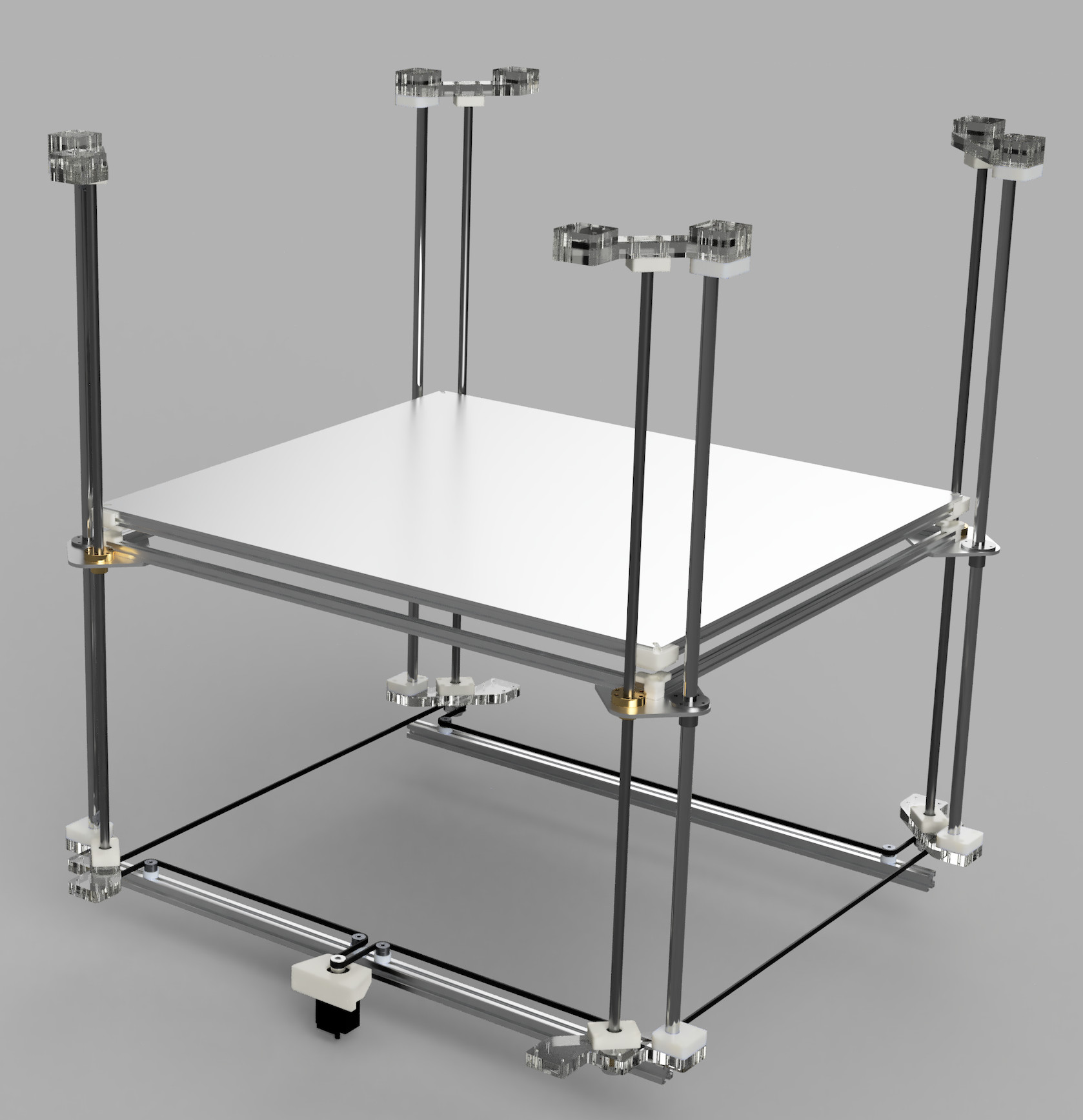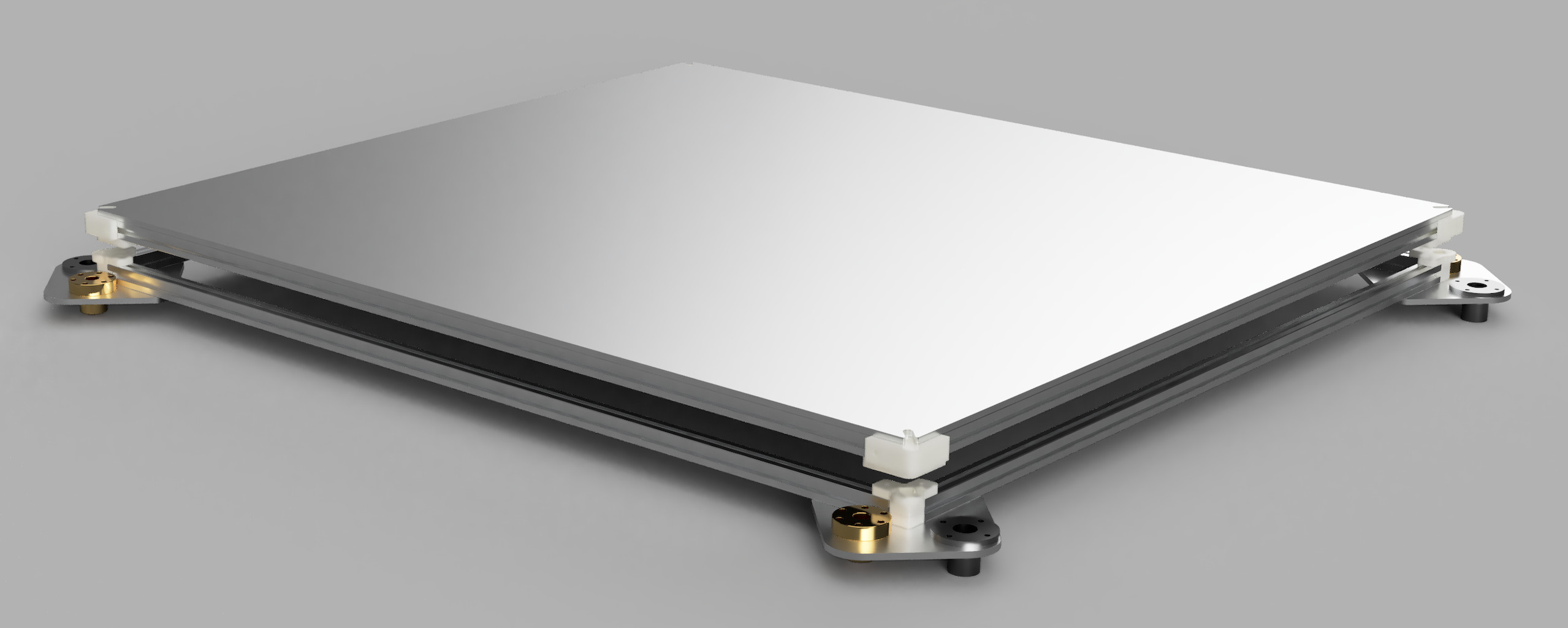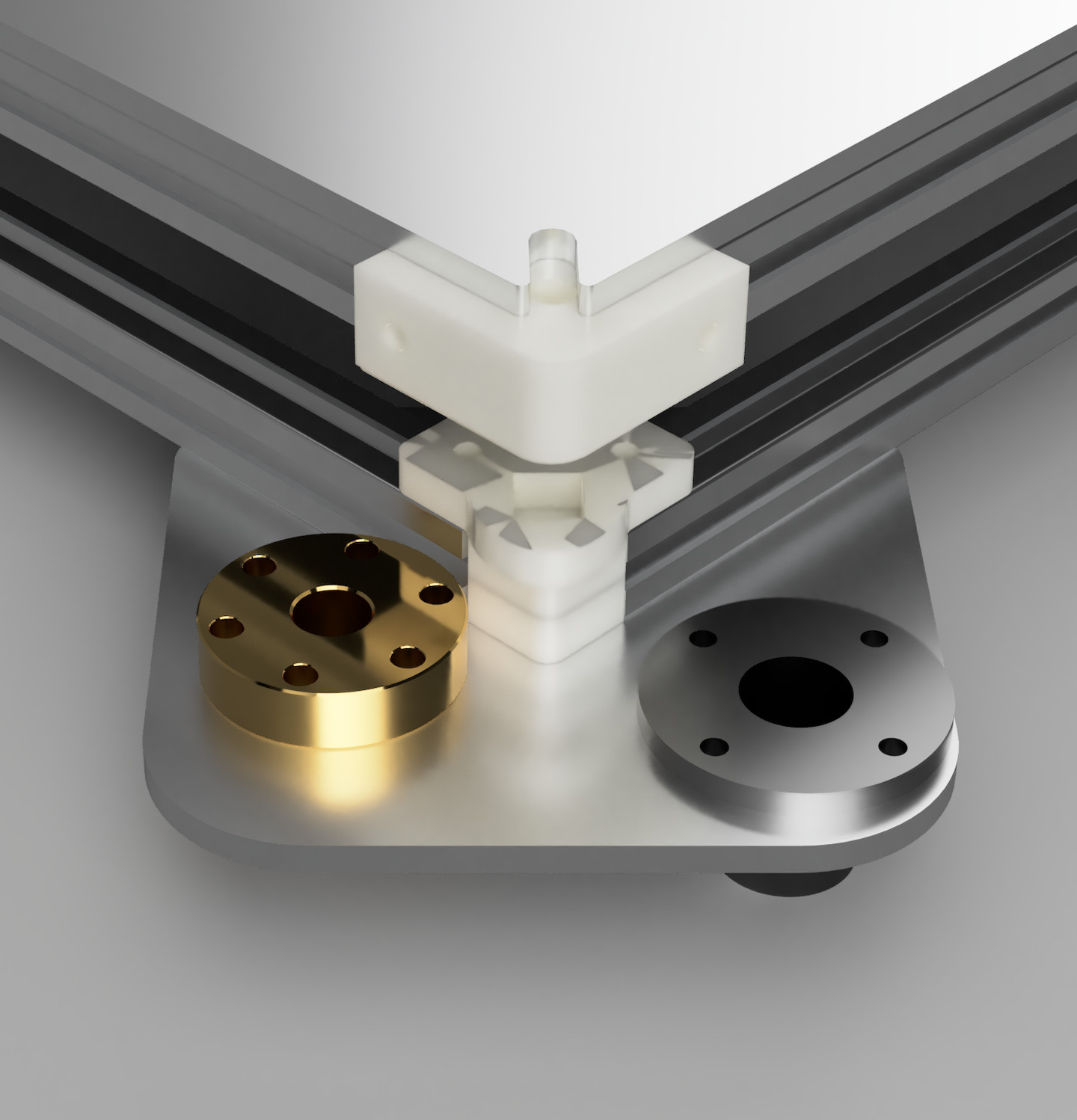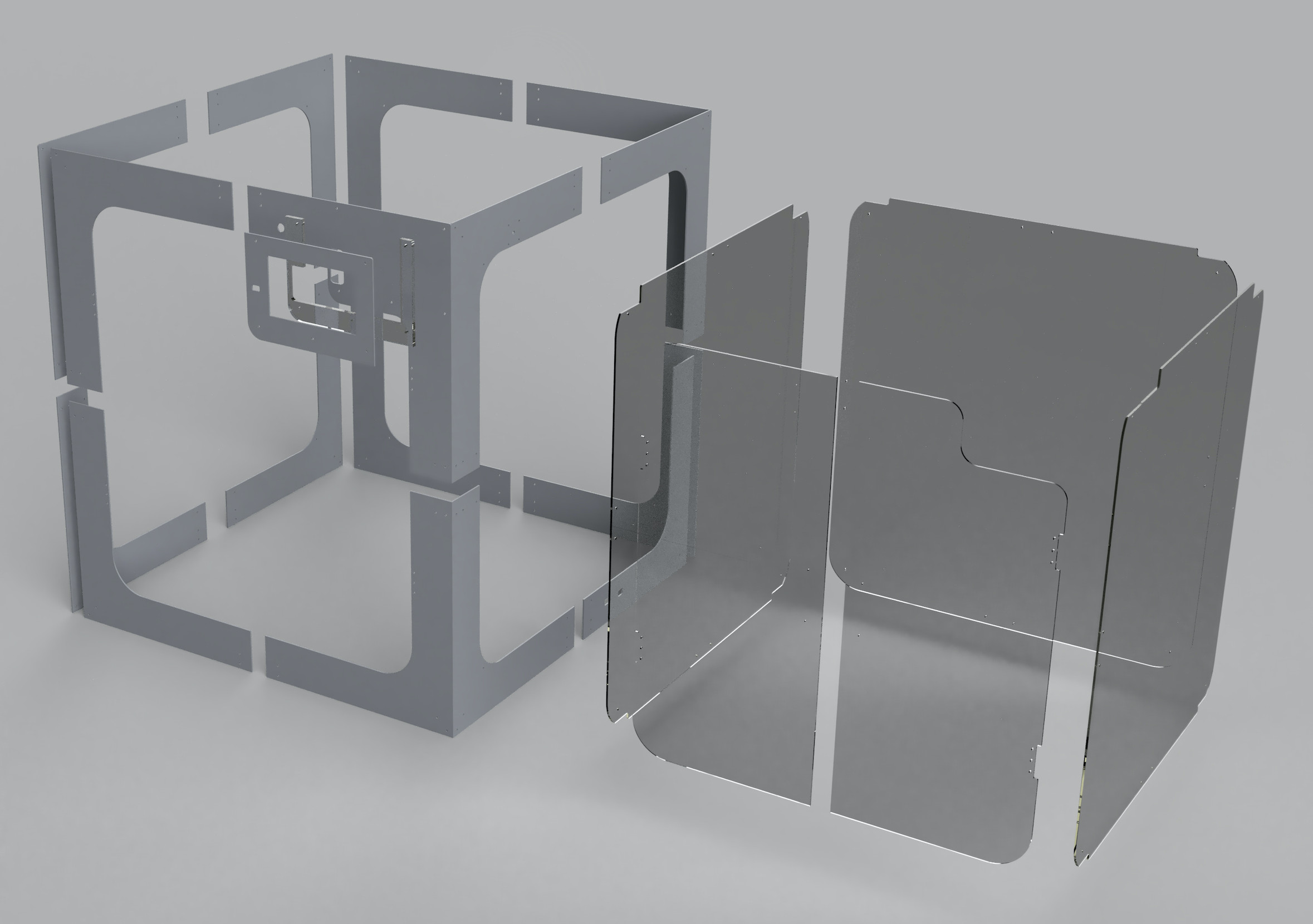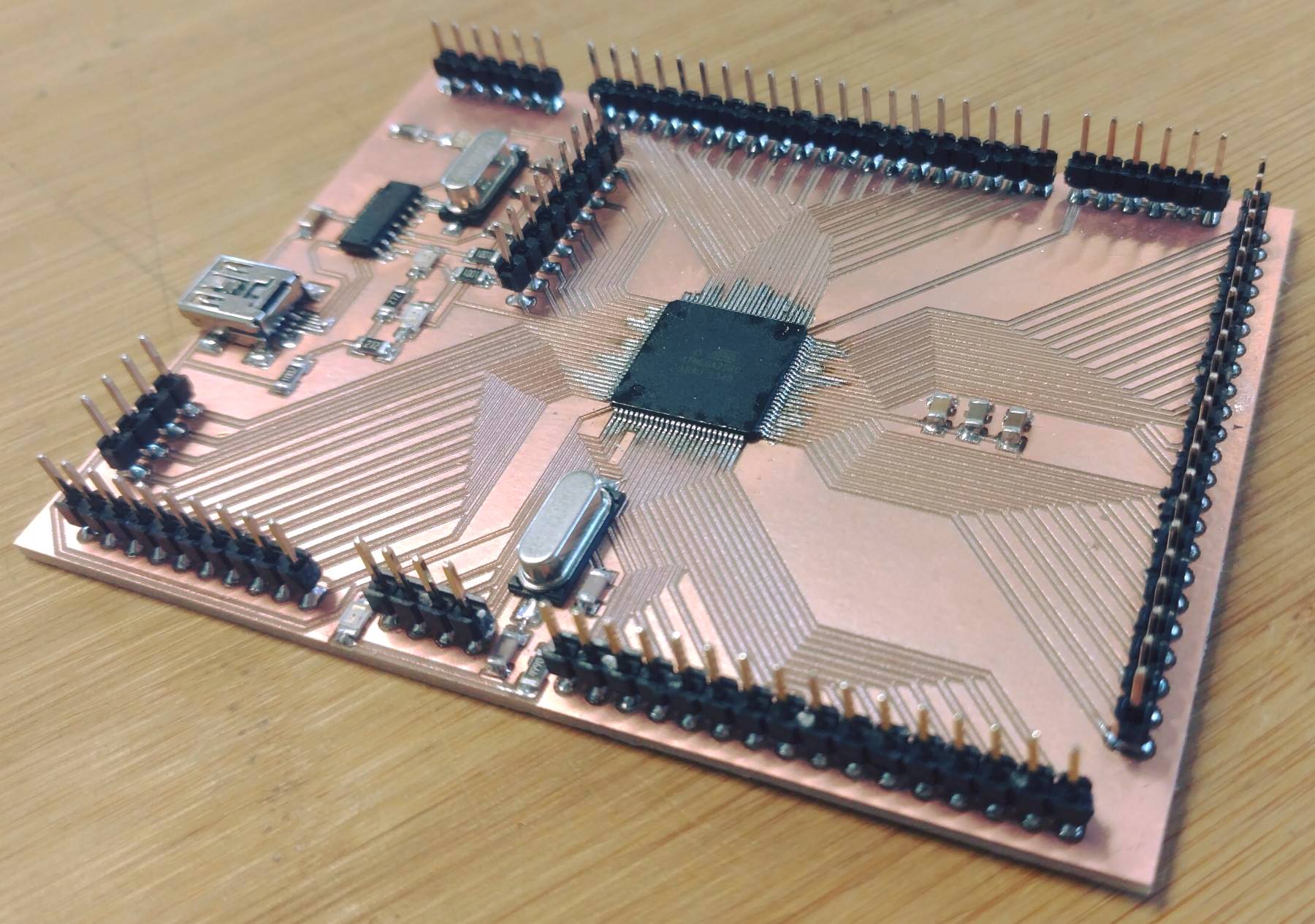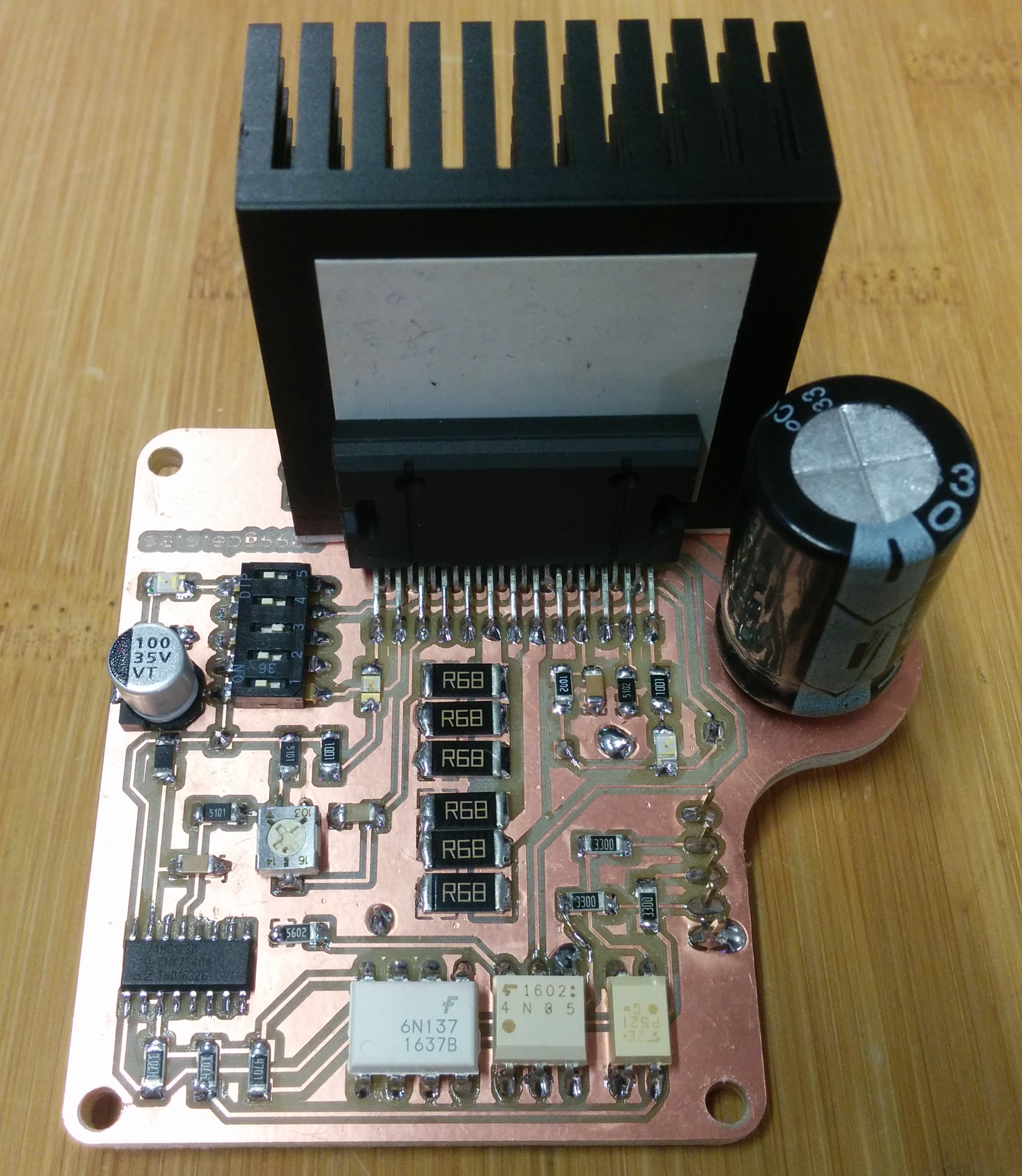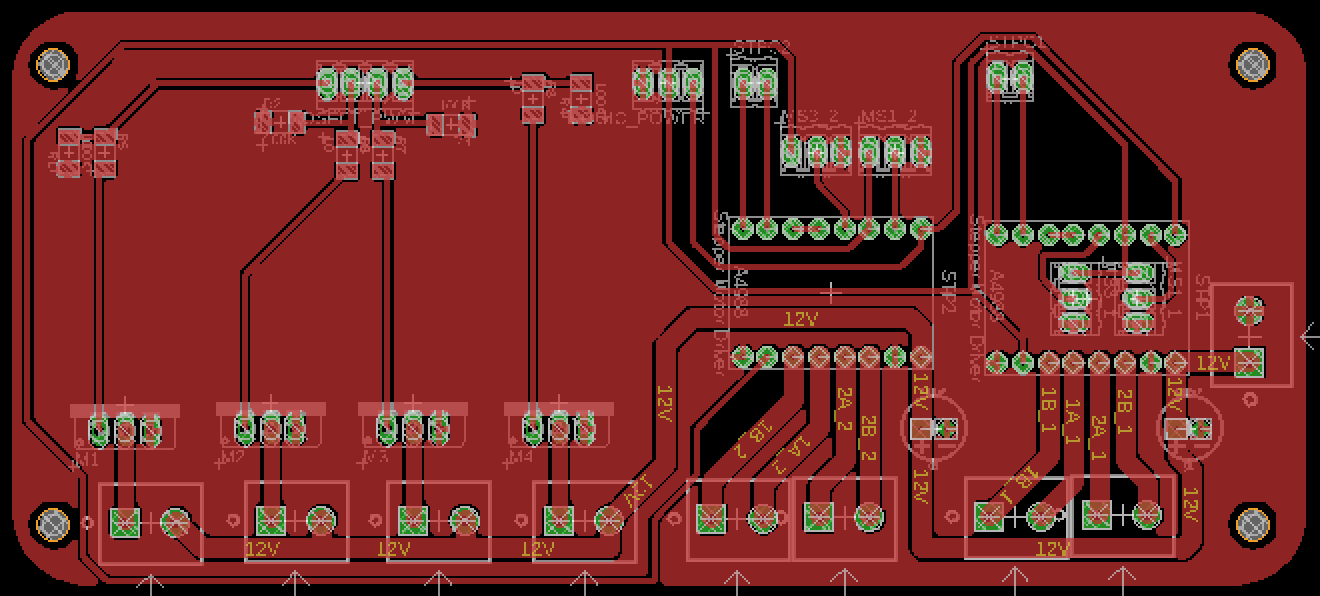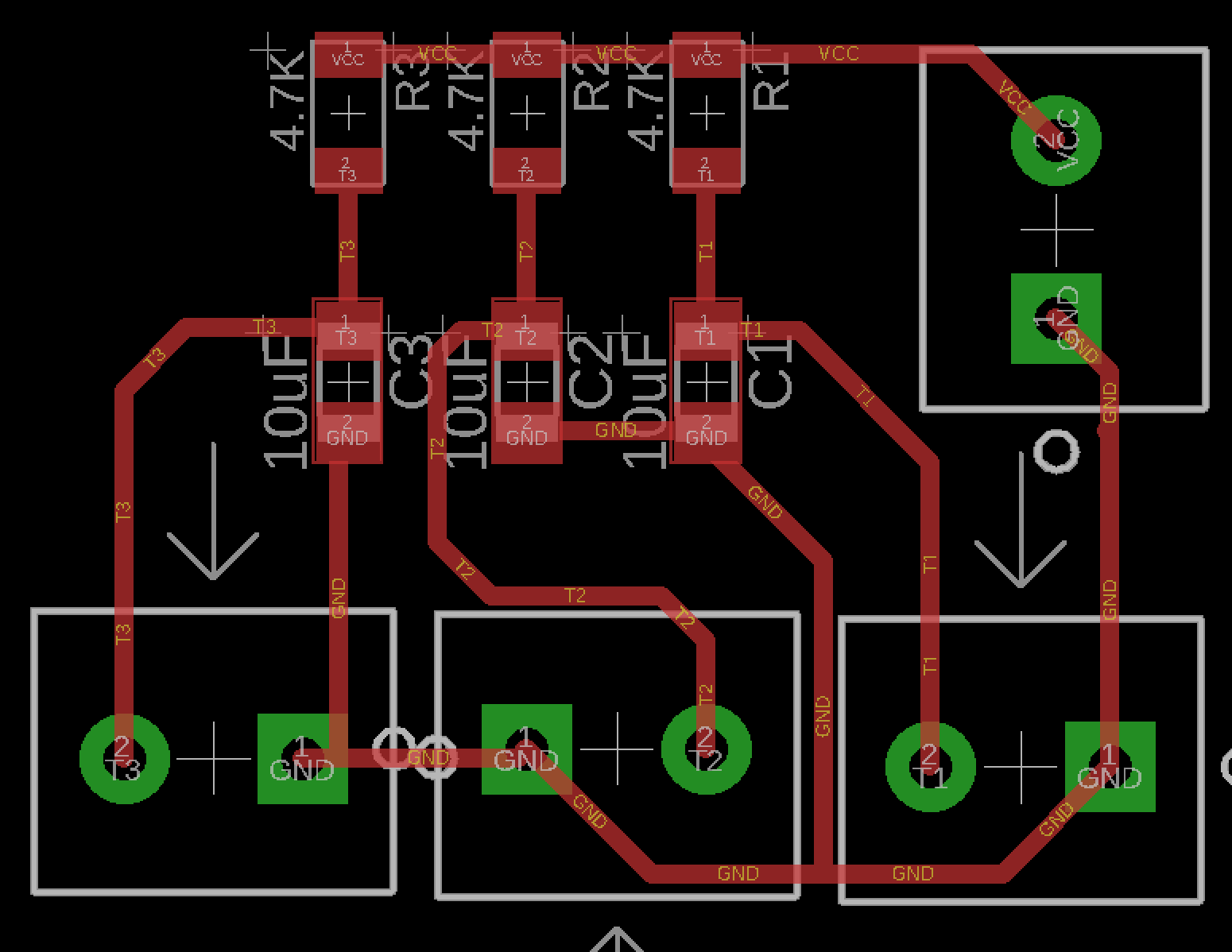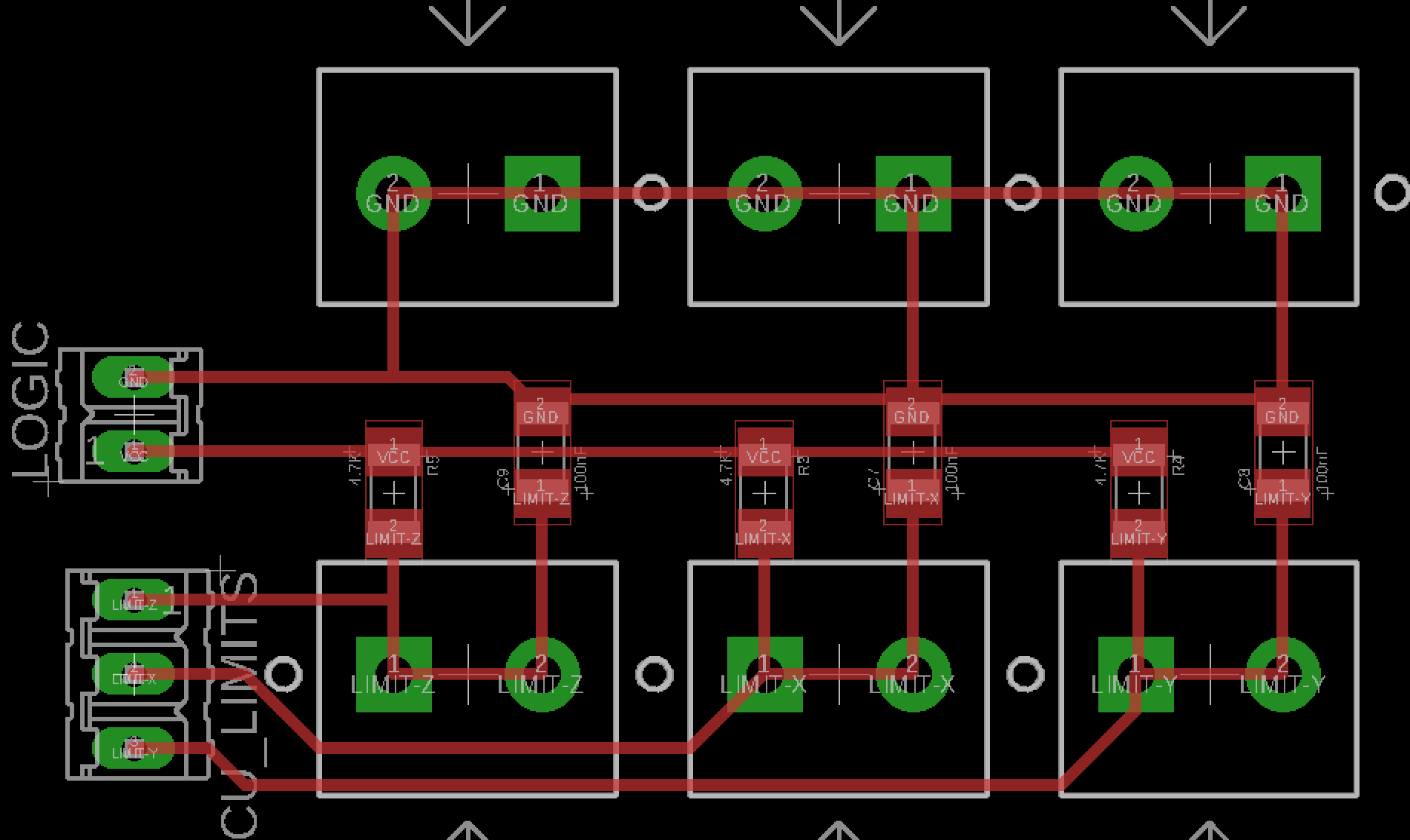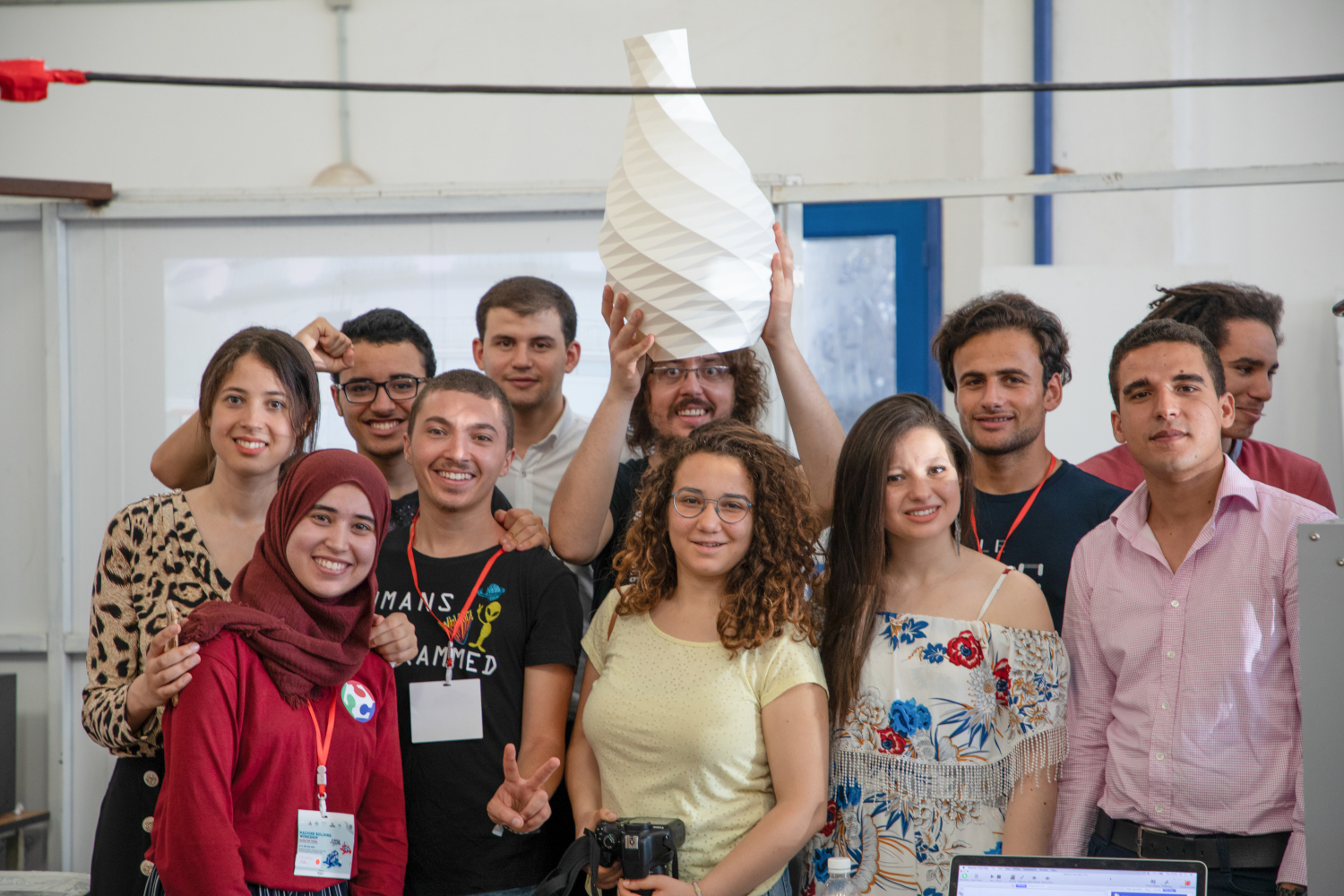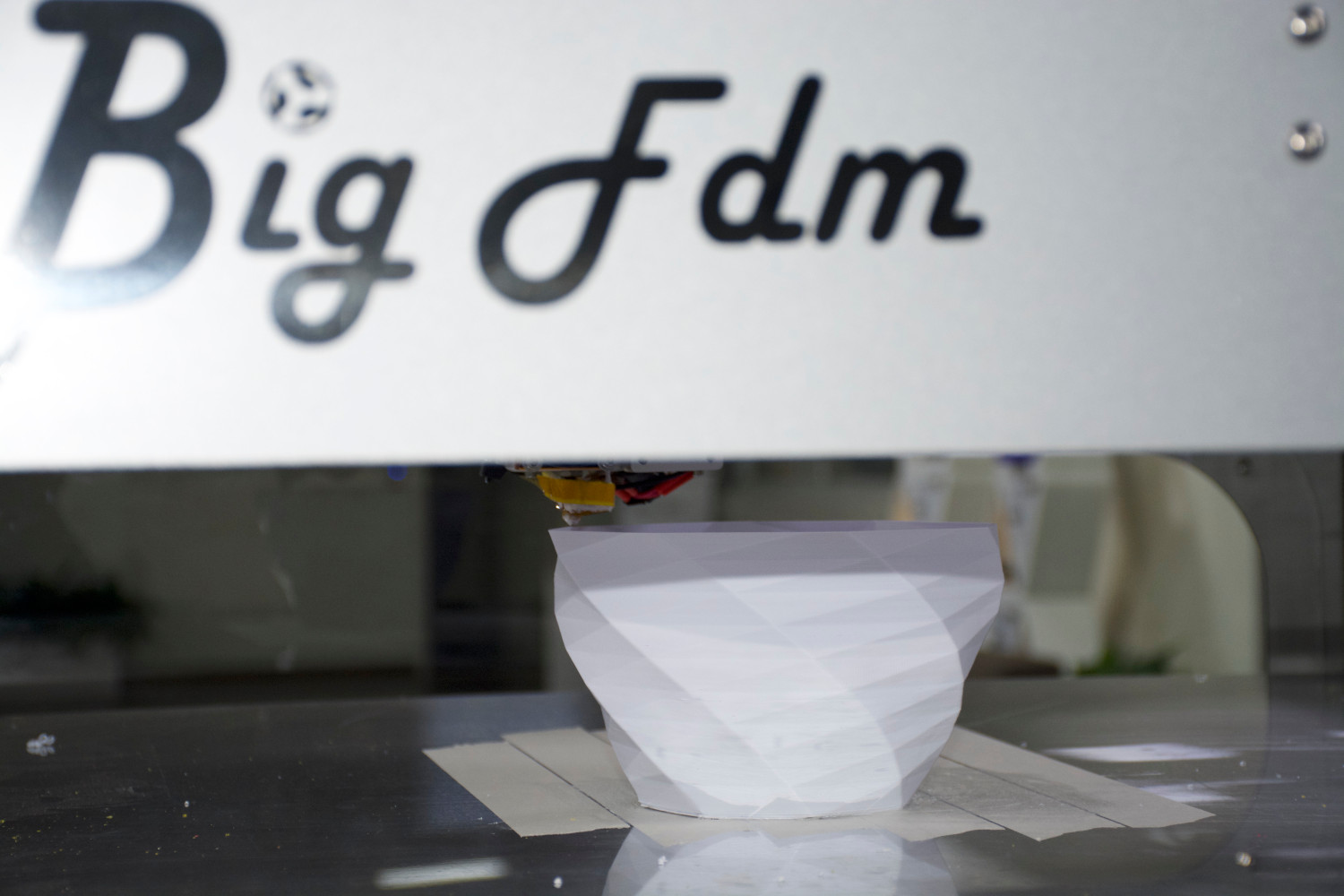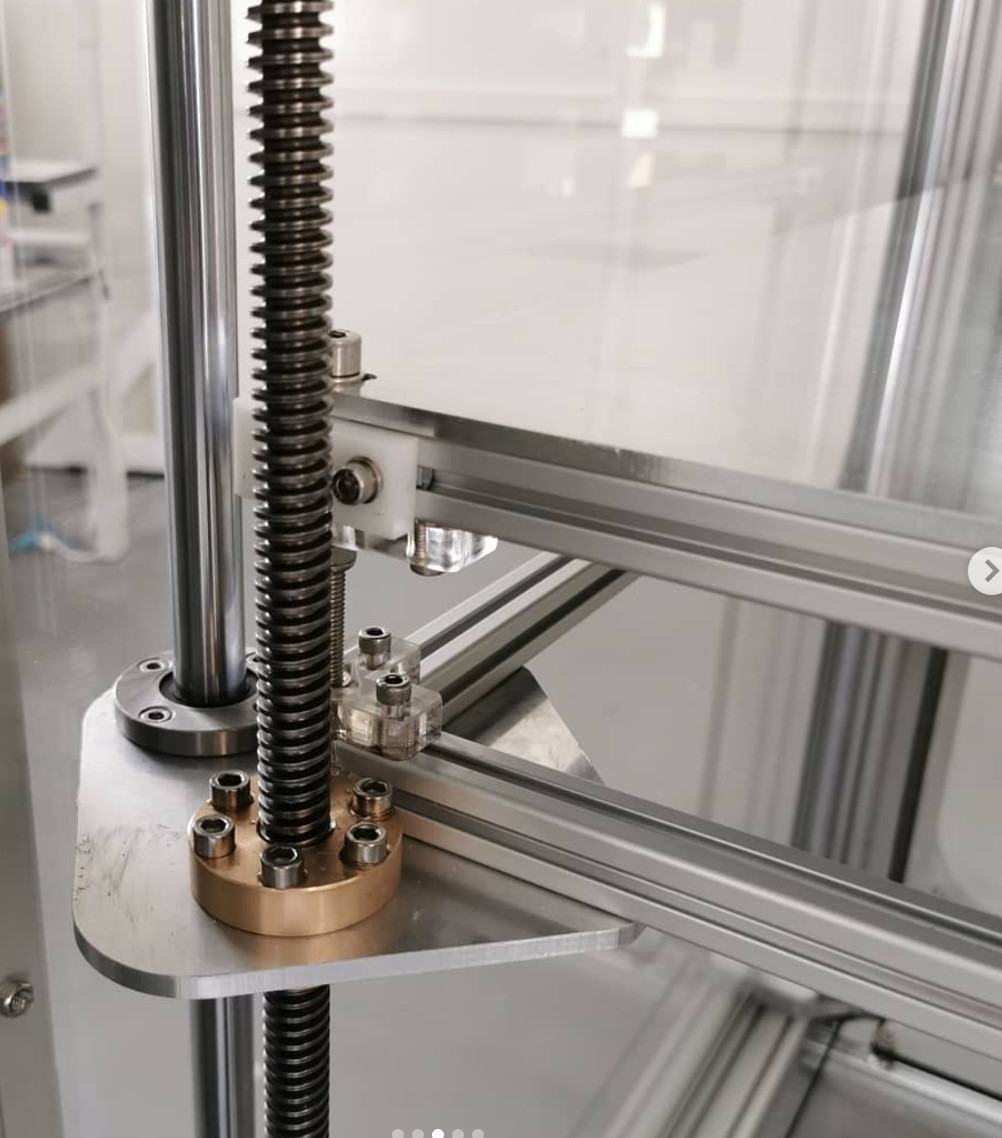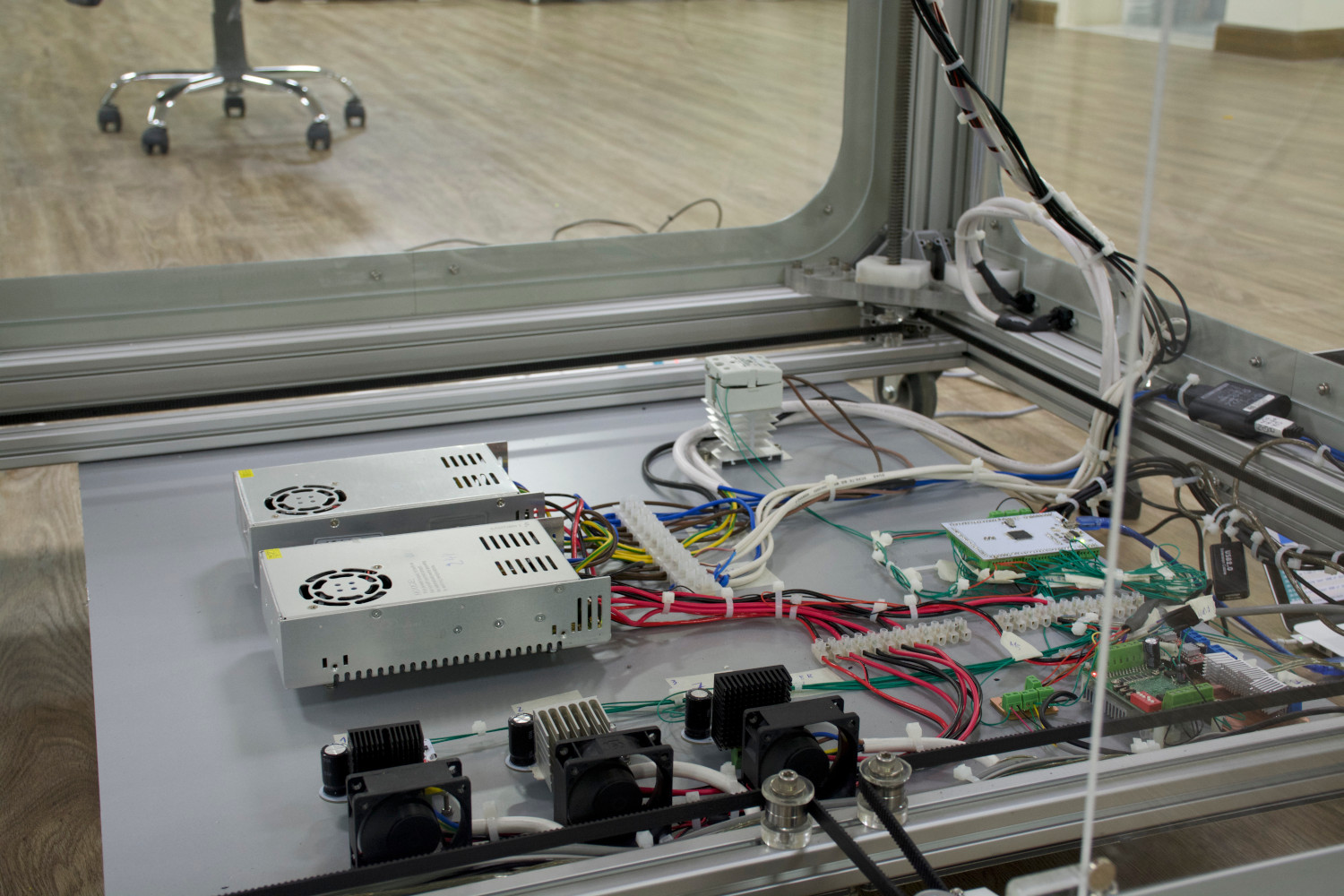We dream in a future of freedom, where open source hardware and Fab Labs enable people to fully understand how to make things they need, and where decentralized local production is customized to impact the surrounding community. Believing that empowering the user with knowledge about how to make machines, BigFDM wants to give to the world a powerful open source tool, to 3D print any large scale object you may need. And, together with LaserDuo, this is one of the first steps in developing other machines sharing the same philosophy.
BigFDM is an open source large scale 3D printer.
Taking advantage of what we have learned in Fab Academy, BigFDM has been developed using standard Fab Lab equipment and techniques. BigFDM was in fact built in Fab Lab UAE by Daniele Ingrassia with the help of Hashim Al Sakkaf. Reversing the consumer process, where knowledge and building of machines stays inside a black box managed by companies, BigFDM brings the advantages of an open source development:
- full awareness about how the machine works
- reproducible design
- possibility to customize the machine and/or to build new ones
- built as much as possible with local materials
- local self-fixing and self-production of the machine parts
- community can use and improve the design
- cheap alternative to large scale 3D printers
- use BigFDM as tool to produce other open source machines
BigFDM allows the printing of large scale objects, some examples can be orthotics and prosthesis, art installations, furniture, replacement parts, industrial design prototypes, molds for casting of full scale parts. Using Fused Deposition Modeling (or FDM), it can use standard 2.85mm 3D printer filament, and as well common extruders nozzles.
BigFDM specifications:
- 800mm x 800mm x 900mm printing area
- dual extruder with interchangeble nozzle
- 2.85mm filament
- 0.4 - 1mm nozzle size
- NEMA 24/23 stepper motors
- stages with HiWin linear guides
- anodized aluminium frame
- heated bed with 4 x 750W bed heaters
- closed housing of aluminum composite and acrylic
- fabbable satshakit and satstep based electronics
- integrated tablet for machine control
- printing from USB drive
- BOM cost of about 2600€
- power requirements 220V, 3000W max
BigFDM has been designed considering to keep fixed from the beginning few constraints, which then influenced the rest of the subsequent design choices:
- the all machine parts must be inside a boxed main frame
- the machine XY stages design must be independent and consistent by itself
- the Z axis moves the bed up or down
These have been tought in order to bring the following benefits:
- a compact design that maximize the printing area while minizing the unused space (just 2mm between the bed supports and the housing!)
- minimizing the unused space has lowered the cost of the frame and the housing parts
- the main frame serves both as structural squared reference for all the machine parts and well as body for the housing
- the XY stages can be completely removed without disassembling any other machine section
- the XY stage indipendent design can be reused to develop other machines
- the machine printing area can be scaled up/down just by changing the length of few machine parts
The X and Y stages integrates all their components inside a squared plane frame of T-Slots profiles. Hiwin 15mm linear guides and 10mm GT2 belts, together with custom CNC milled POM parts have been used. Implementing a sort of stages interoperability, the stages frame can be completely detached from the machine, and virtually, plugged into a different machine having similar frame shape (eg a laser cutter). Similar interoperability has also been recursively kept for the Y axis, which can be modified/removed without changing the X axis.
The Z axis uses a single NEMA 24 to move 4 lead screws guided by 4 linear rods and bearings. A 4.7m closed loop HTD M3 belt is used to transmit the movement with a 2 to 1 pulley ratio. The lead screws are supported by ball bearing both at the top and the bottom, where also pulleys are attached. The corner structural parts are made with CNC milled 20mm acrylic, while the rods and bearing supports use CNC milled POM. Because of layer by layer downwards needed movements, the bed will never move fast, with the maximum speed used more for manual movements. The main frame is used as support structure for all the Z axis parts.
Made out of a 6mm aluminum plate cut with the CNC, the printing bed is suspended onto a lower frame structure by using 4 x 8mm DIN 912 bolts. The lower bed frame in turn is attached to the Z axis lead screws and linear rods. The lower frame is kept parallel to the upper stages by mechanically aligning it during the assembly, while the printing bed flatness can be finely tuned by screwing/unscrewing the 4 bolts. The design of the printing bed takes into account its thermal expansion, leaving a tolerance of expansion that exceeds the calculated one from the aluminum.
The housing has been developed to keep the internal temperature stable, and to allow the bed to quickly warmup. Because the machine parts have been constrained to be inside, the housing is attached directly to the main frame, and no additional parts are needed. The corners are made by 4mm aluminum composite (also called as dibond), while the windows are 6mm acryllic. Both materials have been CNC milled and the design is made in a way to fit two full sheets (about 2400x1250mm) of acrylic and one of aluminum composite. The tablet enclousure is made with the same materials, and allows to quickly remove it from the top.
The electronics of BigFDM consists of a set of fabbable electronics, derived from the original satshakit board and satstep stepper drivers, plus some additional boards. Following the used boards and their role in BigFDM.
Based on the ATMega2560, this board provides the necessary microcontroller hardware for the Marlin manage its logic functionalities. Furthermore integrates an USB-to-Serial converter and USB port. Developed as general purpose board, not all the pins will be used. In the future this board will be a custom made solution for BigFDM. Link to the original repo.
Proved to have a robust design by being used in LaserDuo for more than a year, the satstep6600 is the stepper driver used to move the NEMA 23/24 used in BigFDM. Based on the Toshiba TB6600HG it can give up to 4.5A per coil to a single motor, whereas the NEMA 24 used will take a maximum of 4A. Link to the original repo.
Developed as an add-in to the satshakit-mega for BigFDM, the mosfet board integrates 4 mosfets to drive the nozzle heaters and the solid stae relay for the bed heaters, plus two slots for Pololu A4988 or similar stepper drivers. The A4988 are used to drive the two nozzle stepper motors.
The sensor board integrates simple design with filtering capacitors and pull-up resistor. To this board the thermistors from the extruder and one of the thermistor of the bed heaters will be connected, together with the analog pins from the satshakit-mega.
In a similar way of the Sensor Board, the Endstop Boards has some pull-up resistors and some capacitors to filter the noise coming from the endstops. To this board the endstops and the limits min (x-min, y-min, z-min) from the satshakit-mega will be connected. BigFDM uses normally open endstops.
Summary of the needed boards:
- 1 x satshakit-mega
- 3 x satstep6600
- 1 x mosfet board
- 1 x endstop board
- 1 x sensor board
To power all this electronics, and to switch on and off the heaters the following additonal parts are needed:
- 15A 24V power supply
- 25A 12V power supply
- 25A 230V solid state relay
- 3 x 24V fans (for the 3 x satstep6600)
BigFDM uses Marlin firmware running on the satshakit-mega. The configuration changes have been applied into the configuration.h file, you can find it in the config folder of this repository.
To control the machine and to stream the G-Code, Repetier-Host has been used.
BigFDM is made by using a mix of fabricated and ready-made parts. The ready-made parts are selected to be as common/standard as possible, to make the sourcing of them easy in many countries. For both the raw materials needed for the fabricated parts, and the ready-made parts, refer to the Bill-of-Material for details: BigFDM BOM
The fabrication of the parts mainly relays on standard Fab Lab equipment. It will be therefore possible to make BigFDM in any of Fab Labs worldwide having it. Below a list of the required tools and machines:
- C02 laser cutter:
- able to cut 8mm acrylic
- needed for small acrylic parts
- large format wood CNC machine:
- ShopBot or similar, size 2500x1250mm
- to machine the aluminum parts (bed, Z axis supports)
- to machine the aluminum composite for the housing
- to machine the acrylic for the housing windows
- to machine the POM parts (motor holders, attachments)
- 3D printer:
- a small one (20x20x20cm) is sufficient
- to print the filament/cables holders
- Desktop format CNC machine:
- Roland MDX50/MDX20/SRM20 or similar small machine (as well the cheap chinese ones)
- to produce the required PCBs
- standard set of tools:
- spanner key set
- hex key set
- DIN 875
- calipers
- rulers
- screwdriver set
- player set (grabber/cutter etc..)
- clamps
- rubber hummers
Both fabricated and ready-made parts have been modeled inside the BigFDM Fusion 360 model. Using Fusion is possible to export/prepare the parts for production in the following ways:
- right click save as STL, on a body that needs to be 3D printed
- use the built-in Fusion CAM processor for the machined parts
- project on a surface, and then right click export as DXF, for laser cutting
For more details about the tools and once you have all the fabricated and ready-made parts parts available, refer to the for step-by-step assembly instructions and tips: BigFDM Building Manual
Big FDM requires different fabbable PCBs to work. Below the download links for the eagle files that you use to fabricate them:
- satshakit-mega schematic, satshakit-mega board
- satstep6600 schematic, satstep6600 board
- mosfet board schematic, mosfet board
- sensor board schematic, sensor board
- endstop board schematic, endstop board
Download here the configuration files (right click save as):
-
the extruder used is a dual Geetech MK8, which is good up to 0.5mm nozzle but has difficulties in keeping the temperature with an 1mm nozzle; in the future will be replaced by a custom made extruder supporting nozzles up to 2mm
-
because of the difficulties for the extruder to warmup, to save time it is recommended to start heating it manually whenever possible before starting printing
-
the electronics setup requires improvements, especially a custom made board in place of the satshakit-mega and an additonal all-in-one board, replacing the mosfet, sensor and endstop boards
-
the Z axis design needs multiple parts for the supporting corners of the lead screws and the linear rods; in the future replaced by an unique block of CNC milled aluminum
-
the G-Code streaming from the tablet is sometimes gets corrupted and/or interrupts suddenly; is needed to use an higher quality shielded USB cable, or to try Octoprint instead of Repetier host as G-Code streamer
BigFDM printing
How to Make BigFDM: Tunisia Workshop at Fab Lab ENIT
BigFDM pictures
Project Helper:
Hashim Al Sakkaf
Our dream is to have impact by making open source machines digitally available and locally produced anywhere in world. We plan to open a dedicated Fab Lab to foster open machine building and digital fabrication research. Practically several tasks and many expensens have to be sustained to give this dream the chance to have a future. Such as the renting of a proper space, the making/purchasing of proper equipment, the sustainability of our work and lifes. If you share this mindset and BigFDM is useful to you, please help us to make this dream a reality by donating your support:
The development of this machine has been funded by:
German Federal Ministry of Education and Research
Funds implemented by:
OpenLab Hamburg
Helmut-Schmidt-Universität Universität der Bundeswehr
Laboratorium Fertigungstechnik
Holstenhofweg 85
22043 Hamburg
Thanks:
Fablab UAE
176 6 D St - Satwa
Dubai - United Arab Emirates
fablabuae@gmail.com
Paul Anand
BigFDM is licensed under the terms of the open source license: Creative Commons Attribution-ShareAlike 4.0 International (CC BY-SA 4.0).
This documentation will be continuously improved as soon there are updates and/or improvements on the machine.

